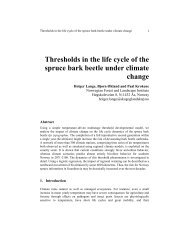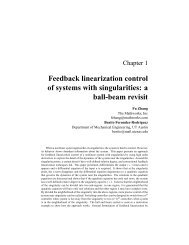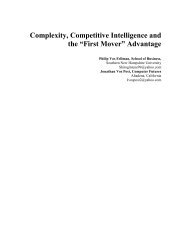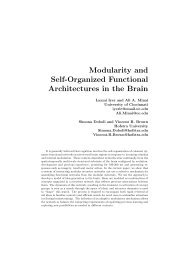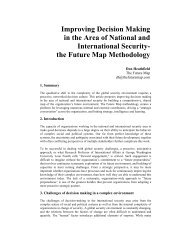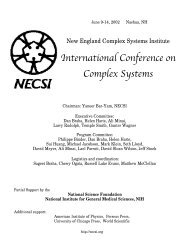Can Models Capture the Complexity of the Systems Engineering ...
Can Models Capture the Complexity of the Systems Engineering ...
Can Models Capture the Complexity of the Systems Engineering ...
Create successful ePaper yourself
Turn your PDF publications into a flip-book with our unique Google optimized e-Paper software.
6<strong>Can</strong> <strong>Models</strong> <strong>Capture</strong> <strong>the</strong> <strong>Complexity</strong> <strong>of</strong> <strong>the</strong> <strong>Systems</strong> <strong>Engineering</strong> Process?systems as internet architecture (Alderson, et al., 2004). The HOT approach has beenadapted to <strong>the</strong> SE process (Wojcik, 2004), resulting in an open-loop control model.In <strong>the</strong> HOT model <strong>of</strong> <strong>the</strong> SE process, <strong>the</strong> function s(t) represents <strong>the</strong> progress <strong>of</strong> <strong>the</strong>SE program and may reach a maximum value <strong>of</strong> 1 if <strong>the</strong> program is completed. Anincomplete SE program will have a maximum value <strong>of</strong> s(t) less than 1. The HOTmodel is based on minimizing total cost across program lifetime, where cost per unittime has three terms. The first term in <strong>the</strong> cost density function is <strong>the</strong> pressure to finish<strong>the</strong> project. Coefficients A and τ generate cost pressure to complete <strong>the</strong> program: <strong>the</strong>larger <strong>the</strong> value <strong>of</strong> A, <strong>the</strong> more cost pressure to complete <strong>the</strong> program. The parameter τis a constant representing how pressure builds up over time; <strong>the</strong> larger <strong>the</strong> value <strong>of</strong> τ,<strong>the</strong> more time it takes for pressure to build up. The second term in <strong>the</strong> cost densityfunction is <strong>the</strong> impact from random events, rolled up into a stochastic function <strong>of</strong> timeto simulate stakeholder interactions, external factors and o<strong>the</strong>r unanticipated events.Two parameters, B (magnitude <strong>of</strong> random event cost impact) and p (probability per unittime <strong>of</strong> random events) combine to form a product coefficient Bp. The third term in <strong>the</strong>cost density function models <strong>the</strong> inherent technical difficulty <strong>of</strong> <strong>the</strong> SE program,parameterized by a coefficient D.Q(t)161412108642Experiments on projected cost <strong>of</strong> AAS based on GAOappropriations01975 1980 1985 1990 1995 2000 2005 2010-2Year123456789Accum Cost101112Each curvecorresponds to adifferent set <strong>of</strong>HOT modelparameters.Details availableupon request.Figure 4. Experiments on projected cost <strong>of</strong> AAS based on program appropriations.To apply <strong>the</strong> HOT model to <strong>the</strong> whole AAS program, we used <strong>the</strong> project plan andoriginal budget to calibrate <strong>the</strong> values <strong>of</strong> A, Bp, D and τ, as <strong>the</strong>y appeared at <strong>the</strong>beginning <strong>of</strong> <strong>the</strong> AAS program. In particular, Bp is set equal to 0. Then, a revised set<strong>of</strong> parameters A*, Bp*, D* and τ* was estimated from <strong>the</strong> actual trajectory <strong>of</strong> <strong>the</strong> AASprogram, using a design <strong>of</strong> experiment (DOE) based on an orthogonal array for fourfactors at three levels and three confirmation runs. The results are summarized inFigure 4, which shows realized cumulative cost <strong>of</strong> <strong>the</strong> program for various parametervalue combinations and a “best fit” to <strong>the</strong> actual cumulative cost. We found that <strong>the</strong>best fit B*p* has non-zero value, A* > A, and D* > D. From <strong>the</strong>se parametercomparisons, combined with post-mortem assessments <strong>of</strong> <strong>the</strong> AAS program, ourinterpretation is that <strong>the</strong> original AAS plan underestimated both <strong>the</strong> level <strong>of</strong> uncertainty<strong>of</strong> <strong>the</strong> effort (B*p* > Bp) and <strong>the</strong> inherent technical difficulty <strong>of</strong> <strong>the</strong> AAS program (D*> D). We also suggest that A* > A may indicate a problem with managerialeffectiveness in <strong>the</strong> AAS program; more pressure to complete was applied from outside<strong>the</strong> program than originally anticipated.
<strong>Can</strong> <strong>Models</strong> <strong>Capture</strong> <strong>the</strong> <strong>Complexity</strong> <strong>of</strong> <strong>the</strong> <strong>Systems</strong> <strong>Engineering</strong> Process? 71.5. Extensions to <strong>the</strong> Original HOT Model Based on COSYSMOCOSYSMO is a parametric cost model for systems engineering projects derived from acombination <strong>of</strong> data from past systems engineering efforts and subjective inputs fromsystems engineering experts (Valerdi, Miller and Thomas, 2004). Data used to generateCOSYSMO parameters comes from systems engineering efforts across multiplesystems and companies (Center for S<strong>of</strong>tware <strong>Engineering</strong>, 2005).We did not attempt to apply COSYSMO to <strong>the</strong> AAS SE process; instead we extend<strong>the</strong> ESE Environment Characterization Template (Figure 1) to include factors in <strong>the</strong>COSYSMO model. These could potentially be scored subjectively to permit estimation<strong>of</strong> HOT parameters A, Bp and D, as suggested in Figure 5.Drivers for Pressure to CompleteDrivers <strong>of</strong> UncertaintyNature <strong>of</strong> ContractReq’s EnvironmentGood PeopleMinimizeImpact <strong>of</strong>SchedulePressureProductivityExperienceLowHighVeteransNew-HiresHighunlikelyPoorReworklikelyMotivationQualitySystem ReliabilityManageabilityCost+trustedHigh-RELLOW-RelHWintenseSWfewIntensive subsManySubsVariableFixed MinTesting“unit”ClearUnclearReuseNewTechTime to Discover ReworkSystem UnderstandingStakeholder EnvironmentTech Maturity/ReuseA = (0,1)F 1 + (0,1)F 2 + … + (0,1)F 4 Bp = (0,1)F 1 + (0,1)F 2 + … + (0,1)F 8Drivers <strong>of</strong> Cost due to Build SpeedNature <strong>of</strong> ContractQualitySystem ReliabilityScope/ScaleCost+trustedHigh-RELLOW-RelReworklikelyunlikely New-HiresVeteransSmall HighBIGprojectLowSimple SpiralComplextasksWaterfallExperienceProductivityDegree <strong>of</strong> DifficultyProcess CapabilityD = (0,1)F 1 + (0,1)F 2 + … + (0,1)F 8Figure 5. COSYSMO-based drivers for HOT SE model parameters, A, Bp and D.1.6. ConclusionsSD emphasizes schedule and is validated against significant past experience. SDpotentially can show emergent behaviors through interactions and feedback loops.HOT models <strong>the</strong> whole SE “iron triangle” (cost, schedule, performance) with arelatively simple model; but it is not well-validated against experience. HOT haspromise as a higher-level model showing emergent behaviors from planning and replanningcycles. COSYSMO is calibrated with expert inputs and past experience andcovers <strong>the</strong> whole triangle, but has less potential for displaying truly emergent behaviors.Retrospective application <strong>of</strong> SD and HOT to <strong>the</strong> single example <strong>of</strong> <strong>the</strong> AAS program is
8<strong>Can</strong> <strong>Models</strong> <strong>Capture</strong> <strong>the</strong> <strong>Complexity</strong> <strong>of</strong> <strong>the</strong> <strong>Systems</strong> <strong>Engineering</strong> Process?inconclusive on whe<strong>the</strong>r modeling can provide useful insight into complexity andemergence in <strong>the</strong> SE process, but we see integration <strong>of</strong> <strong>the</strong> three approaches is apromising approach for future research into complexity in SE, to build on <strong>the</strong> strengths<strong>of</strong> all three approaches: SD for relatively detailed process modeling, HOT for coarse,higher-level modeling, and COSYSMO for calibration reference and tie-in <strong>of</strong> modelingto key factors in previous SE experience. Modeling <strong>of</strong> both successes and failures inpast large-scale engineering programs will provide fur<strong>the</strong>r insights.ReferencesBar-Yam, Y., 2003, “When <strong>Systems</strong> <strong>Engineering</strong> Fails-- Toward Complex <strong>Systems</strong><strong>Engineering</strong>,” International Conference on <strong>Systems</strong>, Man & Cybernetics, Vol. 2: 2021- 2028,IEEE Press, Piscataway, NJ.Barlas, S., 1996, "Anatomy <strong>of</strong> a Runaway: What Grounded <strong>the</strong> AAS." IEEE S<strong>of</strong>tware 13(1): 105.Carlson, J. M. and Doyle, J., 1999, "Highly Optimized Tolerance: A Mechanism for Power Lawsin Designed <strong>Systems</strong>," Physical Review E 60(2): 1412-1427.Center for S<strong>of</strong>tware <strong>Engineering</strong>, 2005, “COSYSMO” web page, University <strong>of</strong> Sou<strong>the</strong>rnCalifornia, http://www.valerdi.com/cosysmo/Cullen, A., 2004, “The Big Money for Big Projects,” Harvard Business School WorkingKnowledge, June 14, 2004, U.S.Del Balzo, 1993, Statement Before <strong>the</strong> House Committee on Appropriations, Submittee onTransportation, Concerning <strong>the</strong> Advanced Automation System, April 19.Erbker, G. W., 1993, Statement <strong>of</strong> Gerald W. Ebker, IBM Vice President Chairman and CEO <strong>of</strong>IBM's Federal <strong>Systems</strong> Company Before <strong>the</strong> Subcommittee on ransportation and RelatedAgencies, House Appropriations Committee.Krebs, M. and J. Snyder, 1988, "Hughes Quits Fight with IBM for Air-Traffic-Control Pact."Automotive News: 8.Levin, R. E., R. D. Wurster, et al., 1992, GAO/RCED-92-264 Air Traffic Control: AdvancedAutomation System Still Vulnerable to Cost and Schedule Problems, GAO: 5.Lewyn, M., 1993, "Flying In Place: The FAA's Air-Control Fiasco." Business Week: 90.Li, A., 1994, Advanced Automation System: Implications <strong>of</strong> Problems and Recent Changes:Statement <strong>of</strong> Allen Li, GAO: 10.Lyneis, J., Cooper, and Els, 2001, "Strategic Management <strong>of</strong> Complex Projects: A Case StudyUsing System Dynamics," System Dynamics Review 17(3).Richard C. Beitel, J., M. P. Dunn, et al., 1998, AV-1998-113 Office <strong>of</strong> Inspector General AuditReport Advance(sic) Automation System, DOT: 8.Scott, W. B., 1988, "Protest Prompts Suspension <strong>of</strong> $3.6-Billion FAA Contract to IBM." AviationWeek and Space Technology 129(7): 27.Valerdi, R., Boehm, B. W. & Reifer, D. J., 2003, “COSYSMO: A Constructive <strong>Systems</strong><strong>Engineering</strong> Cost Model Coming <strong>of</strong> Age,” submitted for <strong>the</strong> INCOSE 2003 Symposium, June29 – July 3, Washington, DC.White, B., 2005, “A Complementary Approach to Enterprise <strong>Systems</strong> <strong>Engineering</strong>,” The MITRECorporation, presented at <strong>the</strong> National Defense Industrial Association 8th Annual <strong>Systems</strong><strong>Engineering</strong> Conference, San Diego, CA.Wojcik, L., 2004, "A Highly-Optimized Tolerance (HOT)-Inspired Model <strong>of</strong> <strong>the</strong> Large Scale<strong>Systems</strong> <strong>Engineering</strong> Process," The MITRE Corporation, in Student Papers: Complex <strong>Systems</strong>Summer School, Santa Fe Institute, Santa Fe, New Mexico, U.S., June 6-July 2.The contents <strong>of</strong> this document reflect <strong>the</strong> views <strong>of</strong> <strong>the</strong> authors and The MITRE Corporation anddo not necessarily reflect <strong>the</strong> views <strong>of</strong> <strong>the</strong> FAA or <strong>the</strong> DOT. Nei<strong>the</strong>r <strong>the</strong> Federal AviationAdministration nor <strong>the</strong> Department <strong>of</strong> Transportation makes any warranty or guarantee,expressed or implied, concerning <strong>the</strong> content or accuracy <strong>of</strong> <strong>the</strong>se views.Copyright © 2006, The MITRE Corporation and Massachusetts Institute <strong>of</strong> Technology. Allrights reserved.



